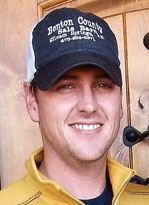
Paul Vaughn returned to Oklahoma after serving in the Army to start his cattle legacy. “I am sure my grandfather had some cattle but, it wasn’t at a large scale until dad,” Paul’s youngest son, Cody said. Paul started buying land and cattle raising strawberries to help pay for land, clearing it and buying cattle. During that time, Paul married Cammela and they raised five children. “There are five of us kids, four boys and one girl. Randy is the oldest. Marty and Olin were next. Then came Cammy and me,” Cody said. “I was an accident they tell me.
“Dad’s dream was to own a sale barn. He built one and opened it in 1990. That is going on 25 years,” Cody said. Paul owns the Benton County Sale Barn in Siloam Springs, Ark. “I was 7 years old when he built the sale barn. I grew up in the cattle business.” Cody manages the sale barn full time now. “With dad getting older, it just fell in my life to fill his shoes as best I could. He is still involved,” Cody said. “He still comes every week to the sale and still buys and sells cattle. He wants to know what is going on and how it is going.”
Two of Paul’s other children work at the sale barn. “Randy works at the sale barn on Thursday when we have the sale. My other brothers Marty and Olin are not involved. My sister Cammy manages the office. She does all the administrative office work at the sale barn,” he said. Cody also manages Paul and Cammela’s cattle operation. “Dad has 3,000 acres with around 1,000 calves right now.”
Cody somehow finds the time to have his own cattle with the help of his wife Aimee. “My wife, Aimee, helps by taking care of the books, does the paperwork and takes care of the baby,” he said. Aimee and Cody have a 20-month-old girl named Jaylen with a little boy on the way. “We have 600 acres near Westville, Okla. I run mostly stocker calves. I buy mix breed calves that weigh 300 to 400 pounds then sell them at 700 to 800 pounds. I buy primarily steers but, will buy heifers at times,” Cody said. “I have 700 calves right now but, that can vary in the spring to as many as 1,100 or 1,200.”
Cody also has a young herd of 4 to 8-year-old cows. “I have 250 cows that are primarily Angus or Brangus cows.” Cody replaces his cows through the sale barn. “Being in the sale barn business and being at the sale every week, if there are some young cows come through, I can always swap out and not have to go through the long term of waiting on a heifer, growing her and breeding her,” he said. “I can just replace through the auction. My herd depends upon what was available at the sale when I needed cows.” Cody has five mostly Angus bulls and does all breeding naturally. “I am currently selling all my calves and not trying to increase my herd,” he said. He sometimes leaves his herd’s calves with the herd, sometimes putting them in with his stocker calves until ready for market. He calves in the fall. “Currently I have newborns to 3-month-olds. They are calving now, every day,” Cody said. He will be done calving in December. “Generally, I take the bulls out of the herd,” he said.
Cody follows the cattle market every day. “I’ve been going to the sale every week learning how the markets can fluctuate week to week for most of my life. I’m involved with it on a daily and weekly basis,” he said. “I mostly help customers, buyers and sellers alike, as manager of the sale barn.” Cody and his full time field representative, Joe Simpson, work with local producers. “We work with producers in Delaware, Washington, Adair and Cherokee Counties basically around a 50 to 60 mile radius from Siloam Springs. We try to do all we can for our customers. They are the lifeblood of our business,” he said. “I try to help producers market their calves as high as I can. I give them advice on weaning or not weaning the calves, whether it is better for them to take them to market now or hold them until later. I evaluate herds giving them appraisals on their herd or calf crop.”
Cody had a few thoughts about the cattle market. “It appears right now cattle prices should, barring no outside disasters or something in the world that is big going on, stay high for a few more years at least because of the supply shortage caused mostly from the droughts,” he said. “Just now, after the good year we had this summer, producers are starting to hold heifers and trying to rebuild their herds. It is still going to be two or three years before those calves are in production.”







